
It was always going to be about Barbuda.
Among these islands lumped together as a tropical paradise, Barbuda is special. It is the only one that is truly unspoilt.
Here, there are no sprawling hotel complexes, no condominiums or cruise liners. No charter flights through the night…
Barbuda, I learned from the Cruising Guide when I first arrived in the Caribbean in 2021, is pretty much as it’s always been. The blue-green sea dotted with coral and teeming with every kind of fish. Endless beaches of the palest pink sand that seem to be entirely deserted.
The island is half the size of Antigua and yet has a population of just 1,634. Mostly, it is left to nature with herds of donkeys, wild horses, deer and goats roaming free.
There is a rather unusual reason for this. The people were originally imported as slaves by the Codrington Family who leased the island from the Crown in 1685 (for an annual rent of one fat sheep). However, the Codringtons did not establish their usual sugar plantation but used Barbuda for growing crops and raising livestock for their workforce in Antigua. Also, the island made a convenient hunting estate (the locals still go out with dogs and guns after wild pigs).
Mostly, the owners left the people to their own devices. This meant that when Abolition came, the Barbudans carried on farming and hunting and fishing in much the same way they always had. Also, they agreed to hold the land communally – which meant that nobody could buy it…
With independence in 1981, the Island found itself amalgamated with Antigua (honestly, how can you have an independent nation of 1,634 people?) But Antigua is not like Barbuda. Antigua is particularly keen on development.
Mind you, the government didn’t have it all their own way: When a construction company spent all day putting up Portacabins ready to build a hotel on Spanish Point, the locals turned up en-masse after dark and pushed them off the cliff.
As the Guide’s celebrated author Chris Doyle puts it: “Many people would love to get their hands on Barbuda’s beachfront real estate, including, at the moment, Robert de Niro and his rich friends with the full connivance of the labor government. Some Barbudans object strongly. It is difficult to know how long they can resist McDonaldsization.”
Well, at least I was getting here first.
But that is the trouble with being a cheapskate. My cruising guide was not even up to date in 2021. I bought it off another boat that was heading for Panama. It is actually dated 2018-2019. It doesn’t even cover 2017 when Hurricane Irma caused the entire population (all 1,634) to be evacuated to Antigua until basic services could be restored – and the government used this as an excuse to amend the communal land law.
So, when I turned up on Friday at Princess Diana Beach, expecting to find 16 miles of unblemished pink sand with just Enoch’s beach bar and lobster grill to break the monotony, I was a bit startled to find a construction site.
This wasn’t what I’d sailed 30 miles for. I turned hard a-port for a couple of miles until I could drop anchor opposite a deserted stretch of beach. Admittedly the boat did settle right on top of a coral head, but you can do that sort of thing when you only draw one-and-a-half metres.
I was just getting out a cold Carib when a helicopter came and landed right opposite – and then another one.
Half an hour after that, an enormous motor catamaran loaded with tourists from Antigua came and drove right up onto the beach, let down a ramp and disgorged its cargo of oiled flesh as if this was D-Day.
Clearly, things have changed a bit since Princess Diana was here in 1997. She chose it specifically because it was so darned difficult for the press to get to.
It wasn’t that easy for me, it being seven miles from the anchorage to Codrington, the capital – or “the village” as the locals call it. A taxi was $70 US return even at 2018 prices and I was still smarting from the engineer’s bill at English Harbour. I got out the bike.
I hadn’t ridden the bike since the Canary Islands, it had a flat tyre and the pump seemed to be broken. I took it anyway. There was a garage in town. Surely somebody would give me a lift.
His name was Chris and he was from Jamaica – an architect on the construction site. He reckoned that a little tasteful development for seriously high-end clients could only be good for the island – maybe they could build some decent roads.
He had a point: The reason a taxi costs so much is because a seven-mile return trip is going to take a while if the fastest you can go is 20mph and even then you’re going to wreck the suspension in the potholes.
Also, he had some bad news: The high-pressure pump at the garage was broken. The good news was that the dive shop could pump up my tyre with a SCUBA tank.
More bad news. The dive shop was closed. In the end, he left me at the General Store in the hope that they might stock a pump.
The General Store was closed because the proprietor had gone down the road. He would be back in fifteen minutes. This I learned from a tall young man with the biggest and whitest teeth I had ever seen. He said his name was Scuzzy and after a couple of beers from the Tummy Feast Restaurant two doors down, he found a SCUBA tank from somewhere and pumped up my tyre.
Then he chaired a Question Time debate among the other Tummy Feast customers gathered in the shade of the General Store (it now transpired that the store was closed because the proprietor was also the proprietor of the Tummy Feast – and that seemed to be more profitable just at the moment.)
The thing is that Barbuda is just getting left behind. It may be great to visit and sit on the beach, but you should try living here. Have you seen the hospital? Don’t fall off that bike…
You can’t stop progress – and it’s not as if there isn’t enough land. They’ve got more land than they know what to do with. Maybe letting a few rich people build a few fancy houses will get them some decent roads…
Yes, they may have a point there. I set off to see the Frigate Bird colony in the north of the Island. That would be another three-and-a-half miles down Route 1 with only the donkeys for company. I was about halfway when it occurred to me that I hadn’t seen a single other vehicle and that if I did get a puncture from one of Route 1’s potholes, it was going to be a long walk back. If I fell right into the pothole and went over the handlebars… well, maybe better not to think about that…
In the end, I never did get to see the Frigate Birds because it turns out the only access is by water across the lagoon. The road takes you to Two Foot Bay – which was charming and ended in a scramble over huge volcanic boulders.
It was only later, sitting over a Carib in Enoch’s that I learned I had missed the Sink Hole too – 80ft deep with an entirely different eco-system at the bottom, all cool and dark and mysterious.
I wouldn’t have known about this either if it hadn’t been for Ian who picked me up on the road back to the beach – yes, I did get a puncture in the end.
Ian works in construction too and invited me to join him and his friends for Happy Hour. That was when I discovered that in fact Messrs de Niro and di Caprio do not have it all their own way.
The PLH development (it stands for Peace, Love and Happiness) may have a paved road and a chain link fence and a cute little security lodge painted pink. But the law still states that no matter how many notices they might put up saying “Private”, the beach is public for six feet from the high-tide line.
…and that includes the island’s oldest residents: the donkeys. Every night, they walk in single file down the beach (sticking to the public part as if they know the rules). Then, under cover of darkness, they graze on the expensive landscaping so painstakingly planted and watered every day for the delight of the seriously high-end guests.
I think that’s a nice touch.

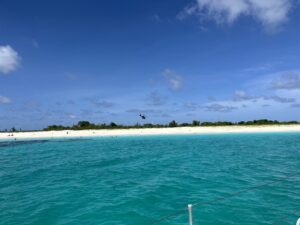


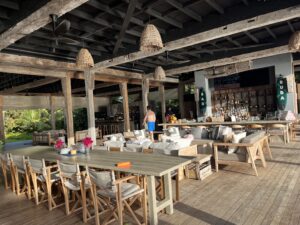









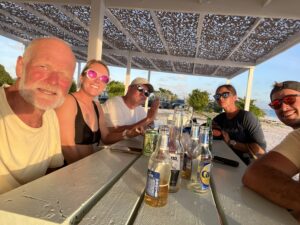





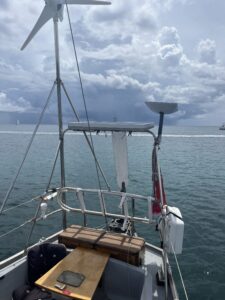




























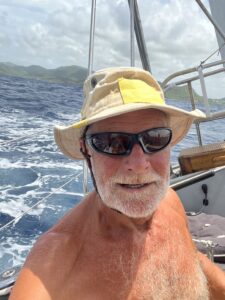
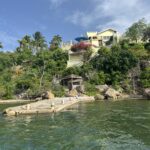




Hi John. I don’t have a UK bank account but I read your wonderful book and gave it 5 stars. Thanks for the great reading, and you definitely don’t “do boring”.